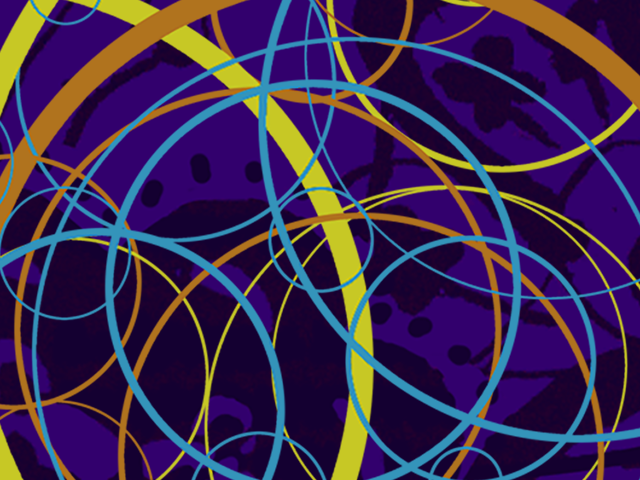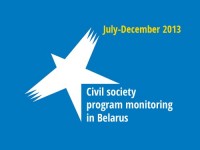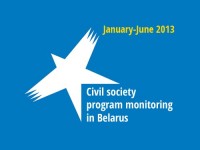Centre for European Transformation has conducted the third comprehensive study in form of monitoring of the implementation of the UNESCO Convention on the Protection and Promotion of the Diversity of Cultural Expressions by the Republic of Belarus.
Monitoring of How the Republic of Belarus Implements the UNESCO Convention on the Protection and Promotion of the Diversity of Cultural Expressions (2022)

Centre for European Transformation has conducted the third comprehensive study in form of monitoring of the implementation of the UNESCO Convention on the Protection and Promotion of the Diversity of Cultural Expressions by the Republic of Belarus.
Summary of the study results
In 2020-2022, the Belarusan cultural sphere was affected by three severe shocks: the outbreak of the new coronavirus infection COVID-19 and the unprecedented measures to combat it; the internal political crisis in Belarus and the ongoing mass repressions against Belarus’ civil society, which were caused by this crisis; as well as the beginning of Russia’s full-scale aggression against Ukraine, in which Belarus supported the former.
During all this time, we have been witnessing a radical reformatting of the Belarusan cultural field: the repressions against creative people; the liquidation of cultural public organizations in Belarus, which caused a mass “exodus” of cultural figures from the country; the rupture of long-established ties, but — at the same time — the establishment of new partnerships, the formation of alternative cultural centers among the Belarusan emigration; and many others.
The Center for European Transformation has completed another comprehensive study of the cultural sphere within the framework of the Monitoring of How the Republic of Belarus Implements the UNESCO Convention on the Protection and Promotion of the Diversity of Cultural Expressions. The first two studies were conducted in 2015 and 2019[1].
The UNESCO Convention on the Protection and Promotion of the Diversity of Cultural Expressions (2005)[2] (hereinafter referred to as the UNESCO Convention) is one of the stages of the consistent development of perceptions and approaches towards culture, formed in the post-war situation and aimed at creating conditions for the manifestation of freedom and peaceful coexistence of different cultures in one space.
The UNESCO Convention has a distinctly political (policy) focus, i.e. it sets the main coordinates in cultural policy of the countries that accept it. This policy should be aimed at the implementation of such goals as rights and freedoms, human self-expression, social engagement, solidarity, mutual understanding and dialogue of communities, peoples, and countries, and a resolution of new challenges associated with the development of technologies.
Thus, the UNESCO Convention is primarily aimed at changing or fixing in cultural policy such mechanisms that would widen the opportunities for participation in cultural production of the widest strata of the population and provide a possibility to manifest one’s identity outside the narrow commercial or strictly functional socio-political frameworks.
The Republic of Belarus was one of the first to sign and approve the UNESCO Convention. However, if earlier the Belarusan state almost exclusively determined both general strategic and conceptual frameworks for cultural practices, and these practices themselves, now after the events of 2020 the situation has changed: we are witnessing the state’s rejection of the basic values and guidelines described in the UNESCO Convention, on the one hand, and the incipience and development in the public environment of subjects professing to set the vector of the future changes in the field of culture, on the other hand.
In 2015, the Center for European Transformation developed a methodology of evaluating the implementation of the values and norms of the UNESCO Convention in the Belarusan cultural practice and conducted a primary study. At the beginning of 2019, a second monitoring study was carried out, which made it possible to compare the situation with the monitoring results of 2015, to highlight the directions, in which positive or negative changes took place.
This short summary of the monitoring results presents the main quantitative assessments, the most important trends and characteristics of the current state of culture in Belarus.
Key findings
The situation in the sphere of culture in Belarus in accordance with the results of the monitoring period of 2020-2022 is characterized by the following main trends:
- Liquidation of positive achievements of the past years. If in 2019 we recorded “restricted progress” in the sphere of Belarusan culture compared to 2015 (gradual development of a variety of subjects, forms and content within the Belarusan cultural field, improvement of conditions for cultural activities), then in 2022 experts spoke of minimum a “roll-back” in development for many years. Separately, it is worth noting a significant and equable drop of experts’ evaluations in almost all dimensions*, which emphasizes the depth and “frontal” nature of the crisis that the cultural sphere has faced.
- Institutional restrictions at key stages of the cultural cycle. The negative situation in the sphere of Belarusan culture in relation to political, economic, and legal conditions inside Belarus is determined not only by the reactive actions of the authorities to suppress and isolate the “cultural revolt”, which have acquired the character of mass repressions, but also by the creation of long-term obstacles to the normal functioning of the cultural cycle** and culture reproduction. This concerns, first of all, restrictions on cultural activities at the stages of “dissemination”, “demonstration/perception/conveyance”, as well as establishing control over “consumption/participation” through extensive censorship practices, restricting access to many independent Internet resources, as well as the interpretation of support “forbidden” performers and cultural institutions as complicity in extremist activities.
- “Asymmetry of publicity” and inequality of opportunities for the development of Belarusan culture within the country and in emigration. The deterioration of conditions for cultural activities inside Belarus caused a mass exodus of cultural figures from the country. At the same time, more favorable conditions were formed for the spread of Belarusan culture abroad. These two factors laid the foundation for the formation of two independent autonomous cultural ecosystems: Belarusan culture in emigration and Belarusan culture inside the country. An additional illustration of this thesis is the fact that some experts, when giving their scores on five dimensions, faced with difficulty in determining the cultural field, gave evaluations separately for the situation inside Belarus and separately among the Belarusan emigration***. The pronounced Belarus-centricity and intention of cultural figures to avoid the situation of separation into those who “left” and those who “remained”, the desire to maintain ties, etc. should be emphasized; although it is not yet completely clear how to preserve this integrity in the activities of cultural actors. The situation is complicated by the fact that cultural activity outside the country exists in a situation of normal publicity, and inside the country often in a semi-underground state, which makes it “invisible” to external observation and research.
- New confrontation. In the pre-crisis period, there was some rapprochement or, to put it better, non-resistance to each other between Belarusan independent and official cultures. To some extent, this was also characteristic of the whole society as a whole — the divide between opposition-minded groups of citizens and groups loyal to the current regime became a less significant obstacle to their coexistence and interaction within society. The socio-political situation of 2020-2022 has led to an aggravation of contradictions and a deepening of disunity and irreconcilability of these two “camps”. Today, such a confrontation is actively stimulated by the current authorities “from above”, and if this policy does not change, then in the long run this division will become more deeply rooted in social reality.
- State policy in the field of culture serves the ideology: from monopoly regulation to the fight against cultural diversity and dissent. Until 2020, the authorities were engaged in regulating the sphere of culture in order to create better conditions and competitive advantages for state cultural institutions compared to other actors, but still allowed some coexistence with independent culture. Today, the main goal of state policy in the field of culture has become the complete marginalization of everything independent, which, among other things, is manifested in the mass practices of a “ban on the profession” and public persecution of figures in the independent cultural sphere. At the same time, the official sphere of culture began to show its propaganda potential more and more and began to serve the ideological practices of the current authorities. Even before, Belarusan official culture performed the function of implementing the ideological guidelines of the current political regime, but at the same time it managed to maintain relatively neutral political meanings, which opened up wide opportunities for cooperation with the independent sphere of culture. Following the repressions, the authorities began large-scale work to rethink and rewrite history, to force “patriotic” practices in society.
- Reducing the potential for reproduction of culture. The decline in the quality of cultural management and education in the field of culture can in the long run lead to the erosion of national culture due to the fact that culture will not be able to fully reproduce itself, continue the traditions of cultural communities, art and creative schools, craft traditions, and conduct scientific research, etc.
- “One-vectorness” instead of “multi-vectorness” and the erosion of the multicultural status of Belarus. Specific cases of oppression of some national and religious minorities by the current authorities (in particular, Poles, Catholics, etc.), as well as the ongoing aggressive rhetoric of the Belarusan state propaganda and senior officials against the western neighbors of Belarus, diplomatic demarches, etc. have the most devastating effect on the attitude of the peoples-neighbors of Belarus towards the Belarusan people. Now, instead of the neutral status of a multicultural country and the image of a tolerant people, the Belarusans are increasingly perceived by the world community as part of the aggressive “Russian world”.
- The growth of “demand” for culture against the backdrop of a reduction of “supply”, which primarily concerns the request for “non-ideologized” culture. This demand is manifested pointwise, by sporadic bursts, agiotage at some cultural events, such as the “Autumn Salon”, and is not satisfied with the offer from “mass culture” that is usually distributed through state infrastructure. This is explained by the fact that over the previous years, certain practices of cultural consumption and participation were formed and developed, which now, with the reduction (due to the displacement of independent culture) and the reformatting of the sphere, do not find space for implementation. The outlines of this phenomenon can be caught by observing official statistics. Thus, we noted in the section dedicated to the analysis of the five dimensions of cultural policy, the sharp and thorough drop of visits to state cultural institutions (theaters, cinemas, concert organizations, museums, circuses, zoos, libraries), which occurred in 2020, was originally associated with only the spread of the COVID-19 pandemic in Belarus. However, in 2021, despite some “recovery” growth, the numbers of these statistical indicators did not reach the pre-COVID level.
- Accumulation of experience of cultural participation as a basis for the consolidation of society and a factor in its development. The creative boom of 2020, which included courtyard concerts, lectures, poster competitions, protest music, the creative work of the masses during street protests, the arrangement of the cultural environment of courtyards, etc., has changed the forms of cultural participation. For a significant part of the inhabitants of Belarus, there was a rethinking of the role of culture after it became a visible factor in socio-political mobilization.
- The transition of independent culture to the “online” and “underground” modes is an incentive to develop individual strategies for cultural participation instead of mass cultural consumption. The mass creation of a variety of online products in the absence of a “live” and public offer directs the consumer to the Internet, where there is now a large selection of cultural and educational products. Special mention is deserved by the spread of semi-public formats of cultural interaction, which are based on personal connections and acquaintances: “kvartirniki” (house concerts), home shows, concerts, etc. All this contributes to the development of individual strategies for cultural participation and consumption and destroys the habit of following the cultural mass offer. An important factor here is the consolidation in memory of the experience of 2020 in mastering new ways and forms of cultural participation.
- Growth of informal cultural diplomacy instead of official channels of international cultural cooperation. It is obvious that the negative rhetoric against Western countries, the pressure on national and religious minorities has a detrimental effect on official international cultural cooperation and cultural exchange with Western countries. The retaliatory measures on the part of these countries, as well as the refusal of Belarus itself to participate in cultural cooperation with them, leads to the “closure” of the country, turning it into a “gray zone”. Under such conditions, independent cultural institutions in exile acquire an increasingly important role, which, along with democratic political centers, represent an alternative voice of Belarusan civil society compared to the official Minsk, capable of clearly conveying the anti-war position of the Belarusans, their commitment to democratic values and thus influencing the attitude the international community to the Belarusans and Belarus.
Five dimensions of cultural policy: the UNESCO Convention and reality
The condition of the sphere of culture in Belarus was assessed according to five practical dimensions. These dimensions reflect the goals and principles laid down in the UNESCO Convention, as well as changes in the deployment of cultural policy in order to achieve these goals and principles.
The dimensions on which the monitoring assessment is carried out include:
- Conditions for the development and manifestation of cultural diversity. We are talking about the legal, economic, social, and activity opportunities and conditions that the state and society provide for the implementation of all components of the cultural cycle, including consumption and participation, as well as the presence of discriminations or preferences, social and cultural readiness for cultural diversity;
- Influence of the cultural sector on the development of society. This influence is expressed in the contributions of the cultural sector to the economic development of the country, employment, as well as to personal development (language and other cultural competencies) and the formation of favorable social conditions (tolerance, gender equality, interpersonal trust);
- Internal resources and development potential of the cultural sector. We are talking about the volume of involvement in the cultural sphere, about the expanding of the structure and the improving of the skills of participants, as well as about tools for stimulating and developing the sphere, external and internal support;
- Development of cross-cultural interaction and contacts. We are talking about the volume of joint cultural productions with other countries, exchanges, export and import of products, as well as the development of contacts and interactions between different cultures in the country (communities, cultural groups and ethnic minorities);
- Interaction of subjects of cultural policy (government, business, civil society). Interaction and partnership means the existence of mechanisms and practices for taking part in strategic and program decisions, possibilities and scope of interaction (joint projects and programs)[3].
Experts’ evaluations were obtained through a series of semi-structured interviews, during which 27 experts were interviewed.
In addition to the scores, the experts were asked to prepare arguments for their assessments — examples that justify their assessment: facts, events, situations, etc.
As for their fields of activity, the experts represented the following areas: heritage protection, museum activities, literature, music, visual arts, publishing, cultural management, curating and producing, cinema, theater, as well as social activities and activism, activities as critics and analysts.
The experts were asked to rate each of the five dimensions of cultural policy under the UNESCO Convention on a scale from 0 to 30 points, where 0 points corresponded to a complete lack of development in this dimension, and 30 points corresponded to the almost complete implementation of all the guidelines and principles of the Convention. For a more accurate assessment, the experts were asked to group the scores into several levels: “Extremely low” — 0-6 points; “Low” — 7-12 points; “Average” — 13-18 points; “Enhanced” — 19-24 points; “High” — 25-30 points.
The results of the expert review according to the five basic dimensions of cultural policy
General assessments of the cultural sphere in Belarus according to the five basic dimensions of cultural policy in 2022 allow us to state a significant deterioration compared to 2019 and even 2015:

Next, we will consider the main positive and negative trends in each of the dimensions of cultural policy, paying attention also to the objective indicators collected on each of the dimensions.
Dimension “Conditions for the development and manifestation of cultural diversity”
Expert review
| 2022 | Score: 5,4 | Extremely low level |
| 2019 | Score: 12,4 | Low level |
| 2015 | Score: 11,0 | Low level |
The average score for this dimension was 5.4, which corresponds to the assessment of “extremely low”. In 2019, the assessment of experts was 12.4 points (“low level”).
Description of the “extremely low” score for this dimension
Legal and economic conditions in the country create discrimination and limit the access of certain groups of the population to all stages of the cultural cycle (creation, production, conveyance, consumption and participation). Access to participation in cultural production and consumption is limited by the monopoly of the state or other entities. The level of freedom of speech, dissemination of ideas, cultural self-expression, diversity of the mass media is extremely low. Society is hostile to foreign cultural manifestations.
Main positive and negative trends
The most important negative trends include:
- political repressions, “ideologization” of culture and censorship;
- deterioration of access to a variety of cultural products for various groups of citizens;
- creation of legal and institutional obstacles for the independent sphere of culture;
- destruction of the information space alternative to the state one;
- cultivation of hostility and discrimination in society;
- worsening of financial conditions for the activities of cultural workers, organizations and initiatives.
The most important positive trends include:
- the growth of society’s demand for various types of cultural products;
- creation and improvement of conditions for the existence of an independent Belarusan culture abroad.
Dimension “Influence of the cultural sector on the society’s development”
Expert review
| 2022 | Score: 8,4 | Low level |
| 2019 | Score: 9,7 | Low level |
| 2015 | Score: 8,9 | Low level |
The average score for this dimension was 8.4, which corresponds to the “low level” of the ratings. Compared to 2019, this score has decreased by almost one and a half points.
Description of the “low level” score for this dimension
The sphere of culture makes a weak contribution to the development of the economy: a small amount of private business in the field of culture, strong disproportions in development between different regions. “Cultural content” (art, science, languages) is poorly represented in educational programs and media and has little impact on public consciousness and attitudes. The distribution of time and expenses for culture by the population is based on the residual principle.
Main positive and negative trends
The most important negative trends include:
- decrease in the participation of citizens in the cultural circulation;
- outflow of personnel, unemployment, emigration in the professional cultural environment;
- narrowing of the possibilities and potential for the influence of the non-state sector of culture on the development of society;
- preservation of the practice of using outdated ideas about culture and cultural industries in legislation, public policy and public perceptions.
The most important positive trends include:
- increase of the inclusiveness of culture through the development of new ways of producing, distributing, displaying/transferring and consuming it;
- development and expansion of cultural competencies (ability, habit to be a consumer of cultural products) among a wide range of citizens;
- formation of culture as the most important factor in the consolidation of civil society and the promotion of democratic values.
Dimension “Internal resources and development potential of the cultural sphere”
Expert review
| 2022 | Score: 6,7 | Low level |
| 2019 | Score: 11,6 | Low level |
| 2015 | Score: 10,1 | Low level |
The average score of experts in this dimension is 6.7, which corresponds to the “low level” of ratings. Compared to the monitoring results of 2019, this figure has fallen by almost 5 points.
Description of the dimension
In this dimension, we are talking about evaluating the development potential of the sphere itself. What matters here is the amount of involvement of people in the cultural sphere at all stages: creativity, production, distribution and conveyance, consumption and participation. It is important to expand (or narrow) the diversity of the composition of participants and stakeholders, to overcome internal conflicts, divisions, disintegration and discrimination of individual groups. The potential for the development of the sphere is associated with the level of qualification of the participants, as well as the possibility of improving it. What matters is the availability and accessibility of tools to stimulate and develop the sphere, external and internal support (investments, sponsorship, competitions, internships, scholarships, awards, etc.).
Main positive and negative trends
The most important negative trends include:
- curtailment of independent cultural/cultural-educational infrastructure, projects and initiatives;
- decrease of the level of professionalism of employees of state-run cultural institutions;
- decrease of the quality of education in educational institutions that train professionals in the field of culture;
- accumulation of contradictions and misunderstandings between cultural actors due to the gap in the geographical context.
The most important positive trends include:
- formation of alternative centers of cultural policy;
- accumulation of experience in self-organization and cooperation within the sphere of culture;
- manifestation and development in society of new practices of cultural participation, as well as a surge in creative production and consumption;
- institutional development of foreign cultural space by Belarusan initiatives and organizations;
- strengthening of the identity and cultural manifestation of the Belarusan diasporas as a resource for cultural development.
Dimension “Development of cross-cultural interaction and contacts”
Expert review
| 2022 | Score: 6,8 | Low level |
| 2019 | Score: 13,4 | Average level |
| 2015 | Score: 12,5 | Low level |
The average score for this dimension was 6.8, which corresponds to the “low level” of ratings. In 2019, the assessment of experts was 13.9 points (“average level”).
Description of the “low” score for this dimension
There are few events and places where cultural communication is possible. International contacts are limited to a narrow group of “close” countries and cultures. Imports greatly outnumber exports. Within the country, there are several cultural groups that have preferences, the rest are in a marginal state. The level of knowledge of foreign languages and knowledge of other cultures is low. There is a lack of both hostility and interest in other cultures.
Main positive and negative trends
The most important negative trends include:
- curtailment of state policy aimed at developing the country’s openness to foreign guests and equal cooperation with all states, including Western countries;
- negative impact of Belarus’ complicity in the military aggression against Ukraine on the representation of Belarusan culture abroad;
- difficulties in integrating into a foreign cultural field for Belarusan organizations, creative teams and artists who have resorted to relocation;
- discrimination and pressure against certain religious and national groups.
The most important positive trends include:
- expanding of the representation of Belarusan culture abroad, increasing of the recognition of Belarus on the world stage;
- improving of the perception within Belarusan society of people with “pro-Belarusan views” (bearers and translators of national democratic values).
Dimension “Interaction of cultural policy subjects”
Expert review
| 2022 | Score: 5,5 | Extremely low level |
| 2019 | Score: 10,5 | Low level |
| 2015 | Score: 9,0 | Low level |
The average score for this dimension was 5.5, which corresponds to the “extremely low level” of ratings. In 2019, the assessment of experts was 10.5 points (“low level”).
Description of the “extremely low” score for this dimension
A complete state monopoly on the conduct of cultural policy; the participation of businesses and civil society in cultural production is severely limited. Separate cultural groups and subjects are steadily discriminated against in their opportunities to participate in the cultural process. There are no joint projects and programs.
Main positive and negative trends
The most important negative trends include:
- elimination by the state of signs of dialogue and of the beginning of cooperation with businesses and society in the cultural sphere.
The most important positive trends include:
- accumulation of positive experience of interaction of various subjects in the field of cultural activity;
- formation in emigration of stable and fruitful cooperation of cultural organizations and initiatives with new political centers.
* * *
For a more detailed introduction to the methodology and results of the monitoring of the Convention, we recommend referring to its full version. It contains voluminous factual material, an assessment of the state of legal regulation, statistical data on the state of the cultural sphere as well as practical recommendations for various actors in the sphere of culture and cultural policy.
To access the full version of the report, please fill in the form by clicking here.
We also recommend reading the reports of the previous monitoring stages:
-
Monitoring of How the Republic of Belarus Implements the UNESCO Convention on the Protection and Promotion of the Diversity of Cultural Expressions (2015)

-
[in Russian] Monitoring of How the Republic of Belarus Implements the UNESCO Convention on the Protection and Promotion of the Diversity of Cultural Expressions (2019)

[1] Monitoring of How the Republic of Belarus Implements the UNESCO Convention on the Protection and Promotion of the Diversity of Cultural Expressions (2015)  ; [in Russian] Monitoring of How the Republic of Belarus Implements the UNESCO Convention on the Protection and Promotion of the Diversity of Cultural Expressions (2019)
; [in Russian] Monitoring of How the Republic of Belarus Implements the UNESCO Convention on the Protection and Promotion of the Diversity of Cultural Expressions (2019)  .
.
[2] The Convention on the Protection and Promotion of the Diversity of Cultural Expressions / Accepted by October 2005 in Paris during the 33rd session of the General Conference of the United Nations Educational.
The Convention is signed by the Republic of Belarus, confirmed by President’s Decree d/d August, 4th, 2006 № 490 and took effect on March, 18th, 2007. — Editorial comment.
* See the Diagram in the sub-section “The results of the expert review according to the five basic dimensions of cultural policy”.
** See the section “The UNESCO Convention: goals, provisions, possibilities of evaluating its implementation”.
*** While calculating the total mean score of the dimensions, the scores provided by experts for the situation outside of Belarus were not considered because there were few experts who did it, and frequently the necessity to introduce double evaluations only appeared for separate dimensions.
[3] A more detailed description of frameworks and the process of working out the methodology, see: Monitoring of How the Republic of Belarus Implements the UNESCO Convention on the Protection and Promotion of the Diversity of Cultural Expressions  .
.
Others
-
Monitoring of How the Republic of Belarus Implements the UNESCO Convention on the Protection and Promotion of the Diversity of Cultural Expressions
We present a monitoring report of how Belarus Implements the UNESCO Convention on the Protection and Promotion of the Diversity of Cultural Expressions.
-
Civil society program monitoring. Analytical report (July-December 2013)
The Centre for European Transformation has prepared a analytical report of the Civil society program monitoring of Belarusan civil society in the period from July to December 2013.
-
The Eastern Partnership Roadmap to the Vilnius Summit
Both the EU and the Eastern partner governments need to communicate more openly and to improve the engagement of the public and of all stakeholders, from business to civil society, in policymaking, if they are to strengthen the effectiveness, accountability and sustainability of policy outcomes, the Eastern Partnership Civil Society Forum (EaP CSF) indicates in its latest set of reports on implementation of the Eastern Partnership roadmap to this month’s Vilnius Summit.
-
Civil society program monitoring. Analytical report (January-June 2013)
The Centre for European Transformation has prepared a analytical report of the Civil society program monitoring of Belarusan civil society in the period from January to June 2013.








Comments
Andrei Yahorau — Al Jazeera: “Lukashenko is irresponsible”
He said Belarus would likely face economic tightening not only as a result of the coronavirus pandemic but also a Russian trade oil crisis that worsened this past winter.